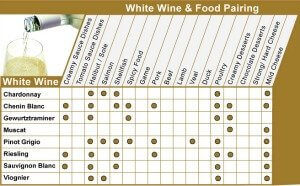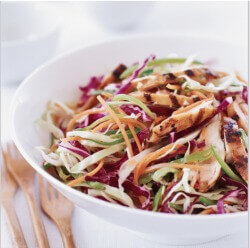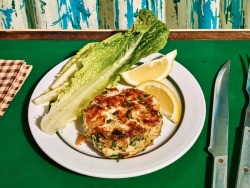
Acidity levels in wine is one of the most important factors when pairing food and wine. Acidity is the ultimate contrast to an array of dishes, including rich, salty, or fatty. If you have a food dish that’s higher in acidity, and a wine that’s higher in acidity, they will cancel each other out. Because they cancel each other out, they won’t be overwhelming making it hard to enjoy the dish. There are also the flavors of the food and wine: they can be matched using similarities or they can contrast, but the intensity should be equal.

You may think that sweet white wine won’t pair with much of anything, and would be best as an after-dinner wine, but that’s incorrect. While sweet wine pairs well with sweet foods, it’s also complementary to all kinds of dishes including: spicy, salty, and sour dishes. With that being said, the sweetness level in food should always be less than the sweetness level in the wine. You don’t want the sweetness of the dish to overpower the sweetness of the wine because that interaction accentuates acidity and bitterness. If your wine is on the sweet side, there will be a pleasant contrast to more savory dishes.
The bubbles in sparkling wine have a cleansing effect and can be refreshing for the drinker. Salty foods are great to pair with wines that have a higher effervescence because of that refreshing effect. Bitter foods also do well with wines of a higher effervescence because the bubbles cut through the negative impact of the bitter.
While it may seem like there a lot of rules to follow, and can be a bit overwhelming, as you try more wines, you will become more aware of their characteristics (it’s all in the name of learning, guys). Keep in mind that while you can match the sweetness and the acidity of wines, you should avoid matching the bitterness. Sweetness can mask bitterness, but highly salty and bitter foods can bring out the negative in wines. If any dish has an overtly high level of something (sweet, sour, bitter, etc.) it can ruin the flavor profile of the wine. And when in doubt, remember light wine is best for light foods and complex wine is best for rich foods.
Below are two different wine pairings to try. The recipes that are chosen will pair well with each wine for different reasons, and also give you an idea of what to look for the next time you’re pairing a wine with a dish.
Riesling Recipe – Grilled Chinese Chicken Salad from Food & Wine
Sauvignon Blanc contains more herbaceous notes, which makes it pair well with green herbs and vegetables. It is a lighter wine that pairs well with lighter dishes, such as white meat, light fish, and salad. The recipe below is a lighter dish that won’t overshadow that lightness of the sauvignon blanc or be overpowered itself.

Ingredients:
- 1 pound skinless, boneless chicken thighs
- 1/4 cup Ginger-Miso Spice Paste
- 1/4 cup vegetable oil
- 1/4 pound snow peas
- 1 1/2 tablespoons fresh lime juice
- Salt
- 2 scallions, cut into thin 1-inch julienne strips
- 10 ounces shredded coleslaw mix (4 cups)
How to Make:
- Light a grill. Make 1/4-inch-deep slashes in the chicken thighs. In a bowl, combine 2 tablespoons of the spice paste with 2 tablespoons of the oil and spread it all over the chicken. Grill the chicken over high heat until cooked through, 7 to 8 minutes. Let cool, then cut the chicken into thin strips.
- Meanwhile, bring a small saucepan of salted water to a boil. Add the snow peas and blanch for 1 minute. Drain and rinse under cold water; pat dry. Slice in half lengthwise. In a large bowl, whisk the remaining 2 tablespoons of paste with the lime juice and the remaining 2 tablespoons of oil. Season with salt. Add the snow peas, scallions, coleslaw mix and chicken, toss well and serve.
Pinot Grigio Recipe – Cod Cakes from New York Times Cooking
Pinot grigio is a light, crisp wine (when made the Italian style). This means it does well with a light fish. It’s going to complement the fish nicely, and the fish will not overpower the wine. The lemon and zesty flavors that are found in a pinot grigio do well to highlight the flavors of the fish.

Ingredients:
- 4peppercorns
- 1bay leaf
- 1 lemon, cut into eighths
- 1pound cod fillets, or other white flaky fish
- 2tablespoons unsalted butter
- 2ribs celery, trimmed, peeled and diced
- 1medium-size yellow onion, peeled and diced
- 2cloves garlic, peeled and minced
- 1heaping tablespoon mayonnaise, homemade or store-bought
- 2teaspoons Dijon mustard
- 2eggs
- 1 ½teaspoons kosher salt
- ½teaspoon freshly ground black pepper
- 2teaspoons Old Bay seasoning, Lawry’s Seasoned Salt or 1 teaspoon paprika and 1 teaspoon red-pepper flakes, or to taste
- 1‘‘sleeve’’ unsalted saltine crackers, crushed, or 1 heaping cup panko bread crumbs
- ½bunch parsley, roughly chopped
- ¼cup neutral oil, like canola
How to Make:
- Fill a shallow, wide pan with high sides with about an inch of water, and set it over high heat. Add the peppercorns, bay leaf and 1 section of the lemon to the water, and allow it to come to a bare simmer. Place the fish into this poaching liquid, and cook, barely simmering, until the flesh has just begun to whiten all the way through, approximately 6 to 8 minutes. Using a wide spatula, carefully remove the fish from the water, and set aside to cool.
- Empty the pan, and return it to the stove, over medium-high heat. Add the butter, and allow it to melt, swirling it around the pan. When the butter foams, add the celery, onions and garlic, and sauté, stirring often, until the vegetables soften and the onions turn translucent, then transfer them to a large bowl.
- In a small bowl, mix together the mayonnaise, mustard, eggs, salt, pepper and seasoning salt (or paprika and hot-pepper flakes), then add this mixture to the bowl with the sautéed vegetables, pour the crushed saltines or bread crumbs over them and stir to combine. Add the parsley, and stir again.
- Flake the cooked fish into the binding sauce carefully, keeping the flakes as whole as you can manage, then gather them into small balls, and form them into patties, 4-6 for a main course, 6-8 for an appetizer. Place them on a sheet pan or platter, cover loosely with plastic wrap and transfer them to the refrigerator for at least 30 minutes to set.
- Set a large sauté pan over high heat, and add to it the neutral oil. When the oil is shimmering, remove the fish cakes from the refrigerator, and carefully sauté the patties until they are golden brown, approximately 4 to 5 minutes a side. Work in batches if necessary. (A small smear of mayonnaise on the exterior of the patties will give them a crisp crust.) Serve them alone, or with greens dressed in a lemony vinaigrette, with the remaining wedges of lemon.
If you’re interested in learning more about the qualities in wine that you look for in pairing food, join us for a tour!
